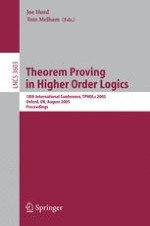This volume constitutes the proceedings of the 18th International Conference on Theorem Proving in Higher Order Logics (TPHOLs 2005), which was held during22–25August2005inOxford,UK.TPHOLscoversallaspectsoftheorem proving in higher order logics as well as related topics in theorem proving and veri?cation. There were 49 papers submitted to TPHOLs 2005 in the full research c- egory, each of which was refereed by at least three reviewers selected by the programcommittee. Of these submissions, 20 researchpapersand 4 proof pearls were accepted for presentation at the conference and publication in this volume. In keeping with longstanding tradition, TPHOLs 2005 also o?ered a venue for the presentation of work in progress, where researchers invited discussion by means of a brief introductory talk and then discussed their work at a poster session. A supplementary proceedings volume was published as a 2005 technical report of the Oxford University Computing Laboratory. The organizers are grateful to Wolfgang Paul and Andrew Pitts for agreeing to give invited talks at TPHOLs 2005.
